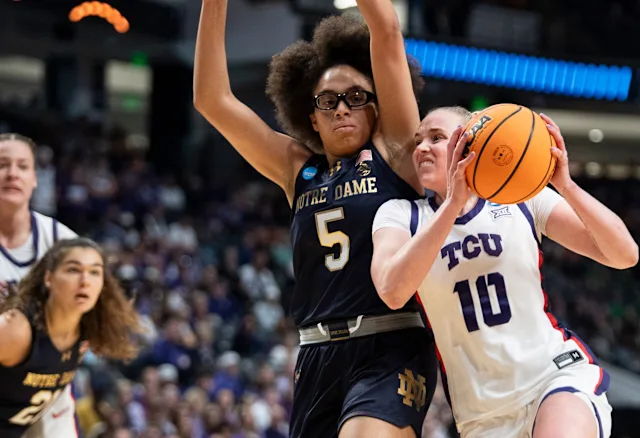The University of Notre Dame’s Fighting Irish men’s basketball team faced a heartbreaking conclusion to their 2024 season with a loss in the Sweet 16, but the post-game atmosphere was about to become even more tumultuous. Following the disappointment on the court, the program’s struggles were compounded by unexpected, and in many ways, brutal news from the transfer portal. While the Sweet 16 loss was difficult to swallow, the departure of key players via the transfer portal brought an entirely new set of challenges that could alter the future of Notre Dame basketball for years to come.
The Fighting Irish’s season had started with high hopes. With a talented roster, a respected head coach in Mike Brey, and a series of solid performances throughout the season, the team had managed to secure a spot in the NCAA Tournament. Fans were optimistic as the Irish took the court in the tournament, especially after a remarkable series of victories that showcased their potential. But a tough Sweet 16 loss against a more physical and dominant opponent brought an abrupt end to their season.
While this kind of defeat can be disheartening for any program, the ripple effects were just beginning for Notre Dame. The transfer portal, which has become an increasingly important aspect of college basketball, had already started to affect programs across the country in recent years, but Notre Dame’s situation was particularly painful. Players who had been vital to the team’s success were now choosing to leave, seeking opportunities elsewhere. This exodus from the program following such a promising season left fans and analysts wondering what the future would hold for the Fighting Irish.
Among the first and most notable departures was the team’s star player, a talented guard who had been the cornerstone of the Fighting Irish’s offense all season long. This player’s decision to enter the transfer portal was a massive blow to the team. The guard had proven himself as one of the top players in the conference, regularly putting up impressive numbers and serving as the leader both on and off the court. His skill set had made him a key component of Notre Dame’s success, and his decision to leave was not just a personal one—it was one that would have lasting implications for the program.
In addition to the guard, several other key players from Notre Dame’s rotation also made the decision to enter the transfer portal. Some were role players, but others had served as important contributors during the season. This mass exodus of talent left the program in a precarious situation. It became clear that Coach Mike Brey would now face a much harder challenge as he tried to rebuild the team for the next season.
For many programs, losing one or two key players to the transfer portal is an unfortunate but manageable setback. However, for Notre Dame, the combination of a bitter Sweet 16 loss and the departure of multiple key contributors was an especially tough pill to swallow. The team’s future now appeared uncertain, as the loss of talented players meant that Brey would need to make significant adjustments to his roster in order to stay competitive in the ultra-competitive world of college basketball.
The transfer portal has had a transformative effect on college basketball, and Notre Dame’s situation was a stark reminder of its impact. In previous years, players who left a program might have been forced to sit out a year, making it less common for high-level players to transfer. However, with the rule change that allows players to transfer without penalty, the dynamics of college basketball recruiting have shifted dramatically. Schools are now forced to recruit players not only out of high school but also from other college programs. The level of competition for talent has never been higher, and Notre Dame was now faced with the challenge of replenishing its roster in the face of intense competition from other programs.
While the transfer portal brings opportunities to improve a roster, it also presents risks. For a team like Notre Dame, the challenge is even greater because of the unique dynamics of the program. While the Irish have a storied basketball history, they don’t have the same level of national recognition or consistent success as some of the top programs in the country. This can make it difficult to attract top-tier talent from the portal, especially when larger programs with more resources are also vying for the same players.
For Coach Brey, the situation required quick decision-making. He now had to focus on rebuilding his roster, filling key holes left by departing players, and trying to create a team that could compete at a high level next season. This would involve not only finding players who could step in and immediately contribute but also maintaining the team’s chemistry and identity. Brey had built a strong culture within the program, and it was essential for him to keep that intact while navigating the changing landscape of college basketball.
Notre Dame’s struggles were exacerbated by the timing of the departures. With the NCAA Tournament now over, many of the top players who had entered the transfer portal were already fielding offers from programs across the country. This made it harder for Notre Dame to act quickly and effectively to secure top talent. The Fighting Irish were no longer operating from a position of strength. Instead, they found themselves scrambling to rebuild their roster in the face of intense competition.
The departures also cast a shadow over the future of the program. The Sweet 16 loss was disappointing, but the news of multiple key players leaving was a devastating blow to the momentum that had been built throughout the season. It forced questions to the forefront about the program’s ability to stay competitive in the future. Could Notre Dame attract top-level talent? Would the departures signal a shift in the program’s overall trajectory? And perhaps most importantly, could Mike Brey continue to lead the team back to prominence in a sport where programs with deeper pockets and more resources often dominate the landscape?
Despite the setbacks, there were reasons for hope. While the loss of key players hurt, it was not the end of the world for Notre Dame basketball. The transfer portal, while often a source of disruption, can also serve as an opportunity for programs to reshape their rosters and bring in new talent. Brey had a strong reputation as a coach and had proven that he could lead his teams to success despite obstacles. While the immediate aftermath of the Sweet 16 loss and the transfer portal departures may have been discouraging, it was still possible for the Fighting Irish to rebuild and find success again in the near future.
Additionally, the program had some bright spots that could serve as the foundation for next season. Despite the departures, Notre Dame still had a core of talented players who remained committed to the program. These players, along with the new recruits and transfers that Brey could bring in, could provide the foundation for a competitive team in the future. The challenge now was to integrate these new pieces into a cohesive unit and continue building the program toward sustained success.
In the ever-evolving world of college basketball, Notre Dame’s recent struggles with the transfer portal are not unique. Many programs face similar challenges, and the ability to navigate these changes is crucial for long-term success. The question now is whether Mike Brey and his staff can weather the storm and lead the Fighting Irish back to prominence. With the right adjustments, the program could emerge stronger from this difficult situation. But only time will tell whether the Fighting Irish can overcome the tough loss and the brutal reality of the transfer portal to reclaim their place as a competitive force in college basketball.
The aftermath of Notre Dame’s Sweet 16 loss will likely be remembered for years to come, not only for the disappointment of the tournament exit but also for the harsh reality of the transfer portal. For the Fighting Irish, this was a challenging moment, one that may define the trajectory of the program for years to come. As the dust settles, it remains to be seen how Notre Dame will respond, but one thing is clear: the road ahead will not be easy, and the program’s future in college basketball hangs in the balance.



